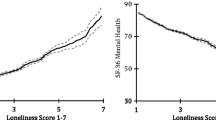Abstract
Increases in hours of work per capita over past 30 years have created an intuitively plausible notion that there now is less time for social interaction. The purpose of this paper is to empirically investigate the effect of hours of work on social interaction. The empirical work is complicated by the argument that unobserved factors could increase both hours of work and social interaction. The empirical work in this paper employs an exogenous decline in hours of work in France due to a new employment law to bypass this endogeneity problem. The data employed are derived from the 1999–2003 Continuous Survey of Household Living Conditions which is a random sample of French households. Gender specific results from a difference-in-difference model show that the employment laws reduced hours of work but there is no evidence that the extra hours went to increased social interactions. Contrary to the intuitive argument, the paper concludes that in the range of approximately 94 extra hours of leisure per year, hours of work have no effect on social interaction.
Similar content being viewed by others
Notes
For more information on the GSS see http://www.norc.uchicago.edu/GSS+Website/ and for more information on the Americans’ Use of Time survey see http://www.bls.gov/tus/.
An increase in the wage also raises money income. The income effect could outweigh the substitution effect for time intensive Z goods with high income elasticities. So an increase in the wage could increase the demand for some time intensive Z goods.
Education affects preferences as well as marginal productivities.
The Loi Aubry decreased hours of work but income was held constant creating a positive wage effect.
The law included incentives for companies that reduced hours of work before the mandatory enforcement date.
Civil Service workers were not included in the same treatment group as workers in small firms since these two groups differ considerably by education and social interaction. See Table 1.
In the part-time group, 26% of these workers are working part-time because they can’t find full time work.
These data are not reported since there is no effect of the compliance date. In addition, the postperiod variable in the regressions support the conclusion of no spillover effect.
EPCV stands for Enquête Permanente sur les Conditions de Vie des Ménages.
INSEE is the Institut National de la Statistique et des Études Économiques (French National Institute of Statistics and Economic Studies).
Membership and Social Interaction section of the EPCV are collected in October of each year.
The number of children living at home would be preferred but is not available in the EPCV.
Race data are not collected in France.
The industry, occupational and geographic variables are not included in Table 1.
The data are the number of hours per week in a typical week or the preceding week. These data are not reflective of annual hours since the number of days worked per year is flexible.
A set of marital status specific regressions were also estimated. In addition separate regressions for those who work a regular schedule, an irregular schedule and who are in specific hourly jobs were also estimated. None of these regressions are reported since the results were very similar to the gender specific regressions in Tables 4, 5 and 6.
References
Arrow, K. (2000). “Observations on social capital”. In Dasgupta & Siragelden (Eds.), Social capital. Washington DC: The World Bank.
Becker, G. (1965). “Theory of the allocation of time”. Economic Journal, 82.
Blanpain, N., Pan Ké Shon, JL. (1998). 1983–1997 les français parlent de moins en moins, INSEE.
Bolin, K., Lindgren, B., Lindström, M., & Nystedt, P. (2003). “Investments in social capital—implications of social interactions for the production of health, social science & medicine, 56, no. 12.
Costa, D., & Kahn, M. (2003). “Understanding the American decline in social capital”, Kyklos, 56.
Estevao, M., Sa, F. (2006). “Are the French happy with the 35-hour workweek?” IMF working papers, 06/251, International Monetary Fund.
Estrade, MA., Méda, D., & Orain, R. (2001). “Les Effets de la Réduction du Temps de Travail sur les Modes de Vie. Qu’en Pensent les Salariés un an Après?”, DARES: Premières Informations et Premières synthèses, 21.1.
Fagnani, J., Letablier, M-T. (2004). “Work and family life balance: The impact of the 35-hour laws in France”, work, employment & society, 18, no. 3.
Kaasa, A., & Parts, E. (2008). Individual level determinants of social capital in Europe. Acta Sociologica , 51(2).
McPherson, J, Smith-Lovin L., & Brashears, M. (2006). “Social isolation in America: Changes in core discussion networks over two decades”. American Sociological Review, 71.
Michael, R. (1973). “Education in nonmarket production”. Journal of Political Economy: Part 1, 81(2).
OECD. (2009). Society at a glance 2009, OECD social indicators. Paris, France: OECD.
Prouteau, L., Wolff F.C. (2002). “La participation associative au regard des temps sociaux”. Economie et Statistique, 352–353, 57–80.
Putnam, R. (1993). The prosperous community: Social capital and public life. The American Prospect. Spring.
Putnam, R. (1995). Bowling alone: America’s declining social capital. Journal of Democracy, 6.1, 65–78.
Putnam, R. (1996). The strange disappearance of civic America. Winter: The American Prospect.
Putnam, R. (2000). Bowling alone: The collapse and revival of American community. New York: Simon and Schuster.
Rupasingha, A., Goetz, J., Freshwater, D. (2006). The production of social capital in US Counties. Journal of Socio-Economics, 35(1).
Saffer, H. (2008). The demand for social interaction. Journal of Socio-Economics, 37.
Sheldon, P. (2008). “The relationship between unwillingness-to-communicate and students’ facebook use”. Journal of Media Psychology: Theories, Methods, and Applications 20(2).
Acknowledgment
The authors would like to thank Michael Grossman and Dhaval Dave for helpful comments on an earlier draft of this paper.
Author information
Authors and Affiliations
Corresponding author
Rights and permissions
About this article
Cite this article
Saffer, H., Lamiraud, K. The effect of hours of work on social interaction. Rev Econ Household 10, 237–258 (2012). https://doi.org/10.1007/s11150-011-9118-5
Received:
Accepted:
Published:
Issue Date:
DOI: https://doi.org/10.1007/s11150-011-9118-5




